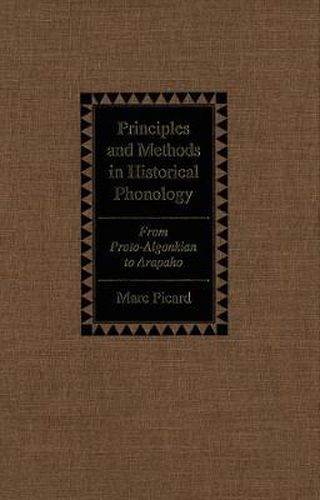Readings Newsletter
Become a Readings Member to make your shopping experience even easier.
Sign in or sign up for free!
You’re not far away from qualifying for FREE standard shipping within Australia
You’ve qualified for FREE standard shipping within Australia
The cart is loading…






Picard’s methodology has three stages: establishing the sound correspondences between a source language (such as Proto-Algonkian) and a target language (such as Arapaho); exploiting the concept of naturalness in phonological change to the fullest in order to construct working hypotheses as to what the most likely historical processes could have been, and to determine in a nonarbitrary fashion which processes could have taken place simultaneously; and ordering these processes in accordance with the various feeding, bleeding, counterfeeding, and counterbleeding relations that exist between a great many pairs of diachronic processes. Picard applies his theoretical assumptions to a detailed development and analysis of the phonological changes that have taken place between Proto-Algonkian and modern Arapaho. In addition he provides a segment-by-segment derivation of over two hundred lexical items, showing exactly which sound changes have applied in each case. Principles and Methods in Historical Phonology is a valuable addition to historical studies of Algonkian languages and will be of particular interest to Algonkianists as well as linguists in general.
$9.00 standard shipping within Australia
FREE standard shipping within Australia for orders over $100.00
Express & International shipping calculated at checkout
Picard’s methodology has three stages: establishing the sound correspondences between a source language (such as Proto-Algonkian) and a target language (such as Arapaho); exploiting the concept of naturalness in phonological change to the fullest in order to construct working hypotheses as to what the most likely historical processes could have been, and to determine in a nonarbitrary fashion which processes could have taken place simultaneously; and ordering these processes in accordance with the various feeding, bleeding, counterfeeding, and counterbleeding relations that exist between a great many pairs of diachronic processes. Picard applies his theoretical assumptions to a detailed development and analysis of the phonological changes that have taken place between Proto-Algonkian and modern Arapaho. In addition he provides a segment-by-segment derivation of over two hundred lexical items, showing exactly which sound changes have applied in each case. Principles and Methods in Historical Phonology is a valuable addition to historical studies of Algonkian languages and will be of particular interest to Algonkianists as well as linguists in general.